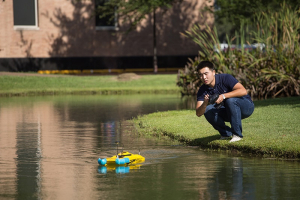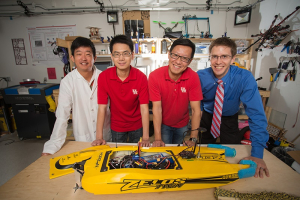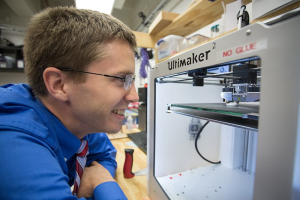Deep below the sea, thousands of sensors collect crucial oceanic data used in environmental monitoring, offshore exploration, disaster prevention and military surveillance. However, there exists a problem underwater which was conquered on land decades ago: There’s no fast way to communicate and deliver information from the ocean depths – no internet, no powerful and clear signals, only delayed communication. But, a new $600,000 award from the National Science Foundation to UH Cullen College professors has them diving in deep to create an underwater communication relay that will outperform anything yet available.
And it starts with robots.
“We can now build these robots that go underwater, swim around and drop off sensors to monitor what happens in our waters,” said assistant professor of electrical and computer engineering Aaron Becker, who serves as a co-principal investigator (co-PI) on the project.
To be clear, these are not yesterday’s science fiction robots that look human – no C-3P0’s here. These robots are autonomous underwater vehicles (AUVs), sometimes referred to as underwater drones.
“My part of the project is to make the robots that are going to shuttle information from the sensors to the surface. My robots are going to swim down, figure out which sensors to monitor, which information to gather and the fastest way to bring that back to our mother ship.”
That description encapsulates the project that intends to create a viable cyber interconnection scheme. The project is called “DEUS: Distributed, Efficient, Ubiquitous and Secure Data Delivery Using Autonomous Underwater Vehicles.”
“We want to collect data from underwater sensor networks in the most efficient, intelligent, secure and cost-effective way,” said the project’s PI Miao Pan, assistant professor of electrical and computer engineering. “And we can do that with the energy of our entire team.”
Underwater Super Scientists
Rounding out the team from Cullen College’s Department of Electrical and Computer Engineering are Professor Zhu Han and Assistant Professor Jiefu Chen.
Think of them all as a band of superheroes, each member with a special skill. Becker is the robot expert, Pan is the data and super security man, Zhu is the algorithm and data collection dude, and Chen is an antenna ace.
“It’s all about assembling the right team, like ‘The Avengers’,” said Becker. Pan concurs: “Our success depends on this team. The most important thing is our synergy.”
Listening in
The robot expert, Becker, is working first on a task called localization, or getting the robots underwater to recognize where they are. “Robots in water are like us before GPS,” said Becker. That takes a moment to digest, until you remember how often you got lost before GPS.
“Once your robot goes more than a few inches underwater it doesn’t have a GPS signal, so the first problem my students and I are working on is how to figure out where you are. It doesn’t know where it is, so it can’t shuttle information back from those sensors.”
Traditionally, scientists used acoustic communication to determine location, the same way we hear whales when they sing underwater. “But the problem with acoustic communication is it has a very low data or transmission rate, a very high delay and a very high error rate,” said Pan.
Said Becker, “It’s also hard to be discreet with acoustic communication – when a whale sings his love song, everyone knows he is in love. Underwater sensors are expensive, so often we don’t want to share our data with the world."
Electromagnetic antennas, the kind commonly in use today, wouldn’t work either because they don’t do much good underwater. So the team needed a new antenna and turned to their antenna ace, Chen.
This is not the first time Chen has had his antenna up. The antenna work in this NSF proposal was based on Chen’s previous work in the private sector where he designed antennas for underground oil and gas exploration.
“It is a similar concept, but one is underground and one is underwater,” said Chen. “We want to make a new antenna, which we hope to boost to the maximum extent that can reach further than existing antennas for underwater communication.”
For this type of antenna, with the robot moving everywhere, he is using magnetic induction, a process where the entire robot becomes magnetized by a magnetic field. But a big antenna attached to a robot would make it become too heavy to move. “So we make an antenna that can conform to the side of the drone – we integrate it to the body of the drone,” said Chen. That means it’s pliable, bendable and flexible.
Information selection and security
When Becker said his robots were going to “figure out which sensors to monitor” from so many streams of information coming from the ocean, he was talking about an old-fashioned math problem. Algorithm and data collection dude, Han, has it solved, though.
“Our algorithm will keep balance between exploitation versus exploration, basically telling us where to go to collect data and from which sensors,” said Han.
He likens the process to slot machines in Las Vegas.
“Imagine you’re in a room of slot machines,” Han explains. “You look around and wonder which one will win. Could it be one that’s already paid out a lot of money? Should I exploit that one? Or should I explore a new one? Our algorithm tells us which sensors will give us the best information.”
He’s working on that winning formula, plus new ways to keep the information confidential. To keep it secure, Pan works with Han on another algorithm and protocol development. “Our goal is to find the way to deliver information privately, with faster transmission rates and lower error and delay rates,” said Pan.
Once the data is back on land, Han processes it with yet more algorithms, reconstructing it and making it as accessible and pristine as possible.
Full speed ahead
The team’s success, with tentacles that touch offshore oil spill response, fisheries management and storm preparedness, will likely impact the economy and well-being of not only coastal regions, but also inland states.
Pan foresees long-range success from this grant for the Cullen College of Engineering, too. Since this is the first-such underwater award from the NSF to the electrical and computer engineering department, he predicts the project will kick off further underwater research in the department.
Becker sees “the big win,” he says, if the team’s breakthroughs become underwater infrastructure.
“This infrastructure includes mathematical theory, antenna design, and robot motion-planning,” said Becker. “We share this through research papers, patents, training students and sharing code.”
So far, they’re doing swimmingly.


